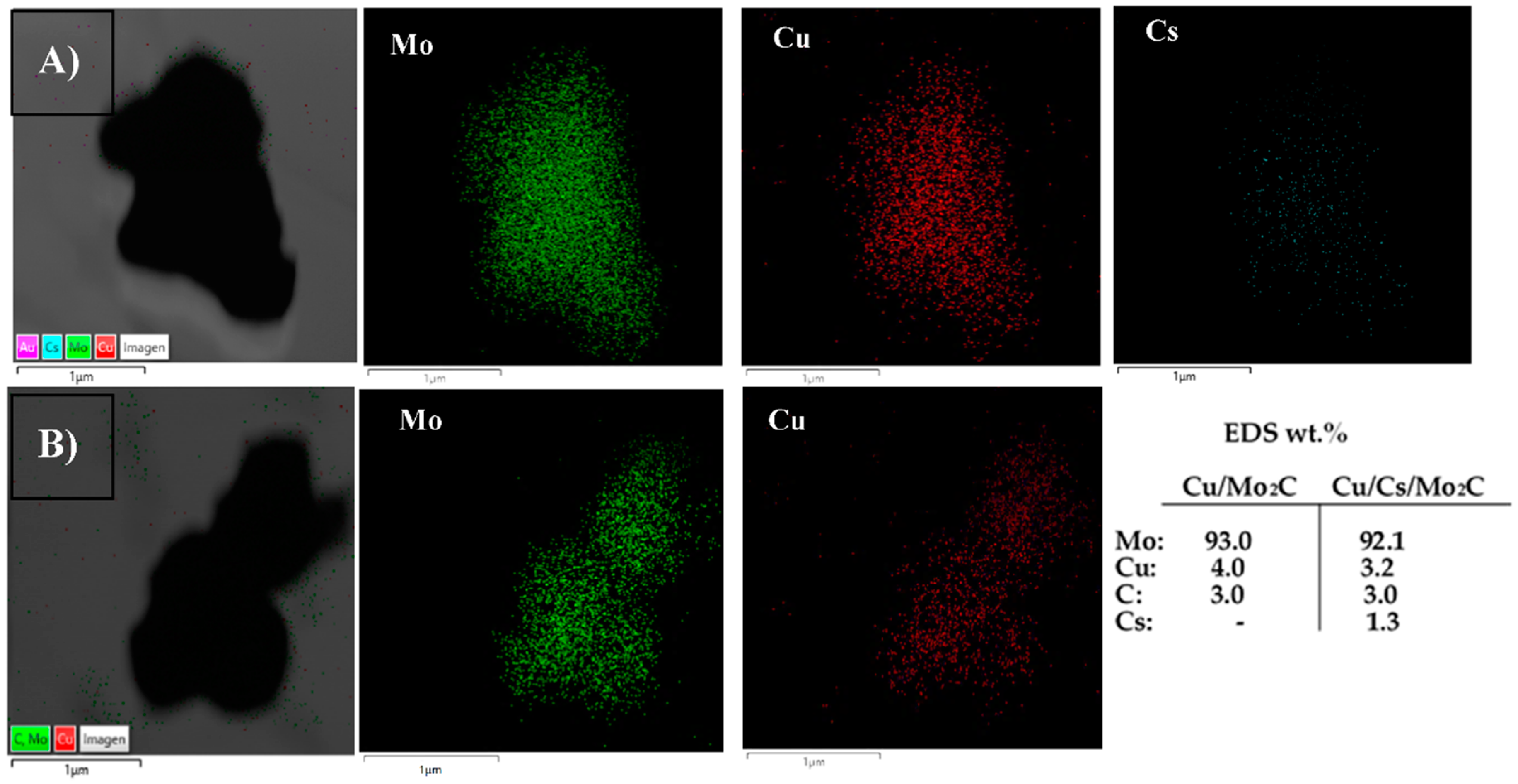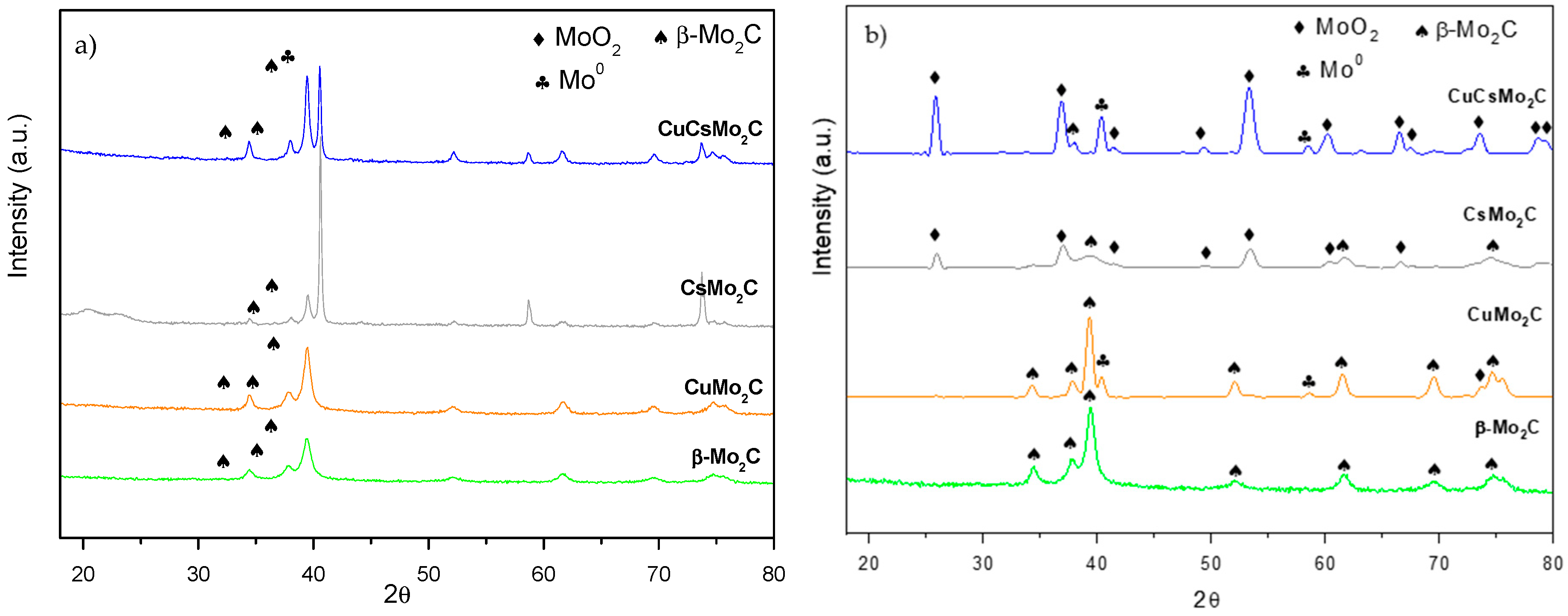Effect of Cu and Cs in the β-Mo2C System for CO2 Hydrogenation to Methanol
Abstract
:1. Introduction
2. Results
3. Materials and Methods
- ni: number of carbon atoms of i.
- moli: number of moles i.
- mol CO2-un: mol of unreacted CO2.
Author Contributions
Funding
Conflicts of Interest
References
- Galadima, A.; Muraza, O. Catalytic thermal conversion of CO2 into fuels: Perspective and challenge. Renew. Sustain. Energy Rev. 2019, 115, 109333–109353. [Google Scholar] [CrossRef]
- Scotti, N.; Bossola, F.; Zaccheria, F.; Ravasio, N. Copper–Zirconia Catalysts: Powerful Multifunctional Catalytic Tools to Approach Sustainable Processes. Catalysts 2020, 10, 168. [Google Scholar] [CrossRef] [Green Version]
- Din, I.U.; Shaharun, M.S.; Alotaibi, M.A.; Alharthi, A.I.; Naeem, A. Recent developments on heterogeneous catalytic CO2 reduction to methanol. J. CO₂ Util. 2019, 34, 20–33. [Google Scholar] [CrossRef]
- Chan-Thaw, C.E.; Villa, A. Metal Carbides for Biomass Valorization. Appl. Sci. 2018, 8, 259. [Google Scholar] [CrossRef] [Green Version]
- Hwu, H.H.; Chen, J.G. Surface Chemistry of Transition Metal Carbides. Chem. Rev. 2005, 105, 185–212. [Google Scholar] [CrossRef]
- Chen, Y.; Choi, S.; Thompson, L.T. Low temperature CO2 hydrogenation to alcohols and hydrocarbons over Mo2C supported metal catalysts. J. Catal. 2016, 343, 147–156. [Google Scholar] [CrossRef] [Green Version]
- Pérez, S.P.; Ramirez, P.J.; Gutierrez, R.A.; Rodriguez, J.A. The Conversion of CO2 to Methanol on orthorhombic β-Mo2C and Cu/β-Mo2C Catalysts: Mechanism for Admetal Induced Change in the Selectivity and Activity. Catal. Sci. Technol. 2016, 6, 6766–6777. [Google Scholar] [CrossRef]
- Nie, X.; Li, W.; Jiang, X.; Guo, X.; Son, C. Recent advances in catalytic CO2 hydrogenation to alcohols and hydrocarbons. In Advances in Catalysis, 1st ed.; Song, C., Ed.; Elsevier: Philadelphia, PA, USA, 2019; Volume 65, pp. 121–231. [Google Scholar]
- Porosoff, M.D.; Baldwin, J.W.; Peng, X.; Mpourmpakis, G.; Willauer, H.D. Potassium-Promoted Molybdenum Carbide as a Highly Active and Selective Catalyst for CO2 Conversion to CO. ChemSusChem 2017, 10, 2408–2415. [Google Scholar] [CrossRef]
- Dongil, A.B. Recent progress on transition metal nitrides nanoparticles as heterogeneous catalysts. Nanomaterials 2019, 9, 1111. [Google Scholar] [CrossRef] [Green Version]
- Liao, W.; Liu, P. Methanol Synthesis from CO2 Hydrogenation over a Potassium-Promoted CuxO/Cu(111) (x ≤ 2) Model Surface: Rationalizing the Potential of Potassium in Catalysis. ACS Catal. 2020, 20. [Google Scholar] [CrossRef]
- Pastor-Pérez, L.; Baibars, F.; Le Sache, E.; Arellano-García, H.; Gu, S.; Reina, T.R. CO2 valorisation via Reverse Water-Gas Shift reaction using advanced Cs doped Fe-Cu/Al2O3 catalysts. J. CO2 Util. 2017, 21, 423–428. [Google Scholar] [CrossRef] [Green Version]
- Perez, L.P.; Saha, M.; Le Saché, E.; Reina, T.R. Improving Fe/Al2O3 Catalysts for the Reverse Water-Gas Shift Reaction: On the Effect of Cs as Activity/Selectivity Promoter. Catalysts 2018, 8, 608. [Google Scholar] [CrossRef] [Green Version]
- Zhang, Q.; Pastor-Pérez, L.; Jin, W.; Gu, S.; Reina, T.R. Understanding the promoter effect of Cu and Cs over highly effective β- Mo2C catalysts for the reverse water-gas shift reaction. Appl. Catal. B Environ. 2019, 244, 889–898. [Google Scholar] [CrossRef]
- Hamdan, M.A.; Nassereddine, A.; Checa, R.; Jahjah, M.; Pinel, C.; Piccolo, L.; Perret, N. Supported Molybdenum Carbide and Nitride Catalysts for Carbon Dioxide Hydrogenation. Front. Chem. 2020, 9, 452–464. [Google Scholar] [CrossRef] [PubMed]
- Posada-Pérez, S.; Ramirez, P.J.; Evans, J.; Viñes, F.; Liu, P.; Illas, F.; Rodriguez, J.A. Highly Active Au/#-MoC and Cu/#-MoC Catalysts for the Conversion of CO2: The Metal/C Ratio as a Key Factor Defining Activity, Selectivity, and Stability. J. Am. Chem. Soc. 2016, 138, 8269–8278. [Google Scholar] [CrossRef] [PubMed] [Green Version]
- Dubois, J.L.; Sayama, K.; Arakawa, H. CO2 Hydrogenation over Carbide Catalysts. Chem. Lett. 1992, 21, 5–8. [Google Scholar] [CrossRef]
- Vidal, A.B.; Feria, L.; Evans, J.; Takahashi, Y.; Liu, P.; Nakamura, K.; Illas, F.; Rodriguez, J.A. CO2 Activation and Methanol Synthesis on Novel Au/TiC and Cu/TiC Catalysts. J. Phys. Chem. Lett. 2012, 3, 2275–2280. [Google Scholar] [CrossRef]
- Xu, W.; Ramirez, P.J.; Stacchiola, D.; Rodriguez, J.A. Synthesis of α-MoC1-x and β-MoCy Catalysts for CO2 Hydrogenation by Thermal Carburization of Mo-oxide in Hydrocarbon and Hydrogen Mixtures. Catal. Lett. 2014, 144, 1–7. [Google Scholar] [CrossRef]
- Tominaga, H.; Nagai, M. Density functional study of carbon dioxide hydrogenation on molybdenum carbide and metal. Appl. Catal. A Gen. 2005, 282, 5–13. [Google Scholar] [CrossRef]
- Posada-Pérez, S.; Viñes, F.; Ramirez, P.J.; Vidal, A.B.; Rodriguez, J.A.; Illas, F. The bending machine: CO2 activation and hydrogenation on δ-MoC(001) and β-Mo2C(001) surfaces. Phys. Chem. Chem. Phys. 2014, 16, 14912–14921. [Google Scholar] [CrossRef] [Green Version]
- Schaidle, J.A.; Schweitzer, N.M.; Ajenifujah, O.T.; Thompson, L.T. On the preparation of molybdenum carbide-supported metal catalysts. J. Catal. 2012, 289, 210–217. [Google Scholar] [CrossRef]
- Wyvratt, B.M.; Gaudet, J.R.; Thompson, L.T. Effects of passivation on synthesis, structure and composition of molybdenum carbide supported platinum water–gas shift catalysts. J. Catal. 2015, 330, 280–287. [Google Scholar] [CrossRef] [Green Version]
- Rozanov, V.V.; Krylov, O.V. Hydrogen spillover in heterogeneous catalysis. Russ. Chem. Rev. 1997, 66, 107–119. [Google Scholar] [CrossRef]
- Srinivas, S.; Rao, P.K. Direct Observation of Hydrogen Spillover on Carbon-Supported Platinum and Its Influence on the Hydrogenation of Benzene. J. Catal. 1994, 148, 470–477. [Google Scholar] [CrossRef]
- Morse, J.R.; Juneau, M.; Baldwin, J.W.; Porosoff, M.D.; Willauer, H.D. Alkali promoted tungsten carbide as a selective catalyst for the reverse water gas shift reaction. J. CO2 Util. 2020, 35, 38–46. [Google Scholar] [CrossRef]
- Yang, X.; Su, X.; Chen, X.; Duan, H.; Liang, B.; Liu, Q.; Liu, X.; Ren, Y.; Huang, Y.; Zhang, T. Promotion effects of potassium on the activity and selectivity of Pt/zeolite catalysts for reverse water gas shift reaction. Appl. Catal. B Environ. 2017, 216, 95–105. [Google Scholar] [CrossRef]
- Behrens, M.; Studt, F.; Kasatkin, I.; Kühl, S.; Hävecker, M.; Abild-pedersen, F.; Zander, S.; Girgsdies, F.; Kurr, P.; Kniep, B.; et al. The Active Site of Methanol Synthesis over Cu/ZnO/Al2O3 Industrial Catalysts. Science 2012, 759, 893–898. [Google Scholar] [CrossRef]
- Sun, J.T.; Metcalfe, I.S.; Sahibzada, M. Deactivation of Cu/ZnO/Al2O3 methanol synthesis catalyst by sintering. Ind. Eng. Chem. Res. 1999, 38, 3868–3872. [Google Scholar] [CrossRef]
- Dasireddy, V.D.B.C.; Štefančič, N.S.; Likozar, B. Correlation between synthesis pH, structure and Cu/MgO/Al2O3 heterogeneous catalyst activity and selectivity in CO2 hydrogenation to methanol. J. CO2 Util. 2018, 28, 189–199. [Google Scholar] [CrossRef]
- Marcos, F.C.F.; Lin, L.; Betancourt, L.E.; Senanayake, S.D.; Rodriguez, J.A.; Assaf, J.M.; Giudici, R.; Assaf, E.M. Insights into the methanol synthesis mechanism via CO2 hydrogenation over Cu-ZnO-ZrO2 catalysts: Effects of surfactant/Cu-Zn-Zr molar ratio. J. CO2 Util. 2020, 41, 101215. [Google Scholar] [CrossRef]
- Blanco, A.A.G.; Furlong, O.J.; Stacchiola, D.J.; Sapag, K.; Nazzarro, M.S. Porous MoxCy/SiO2 Material for CO2 Hydrogenation. Top. Catal. 2019, 62, 1026–1034. [Google Scholar] [CrossRef]
- Mureddu, M.; Ferrara, F.; Pettinau, A. Highly efficient CuO/ZnO/ZrO2 @ SBA-15 nanocatalysts for methanol synthesis from the catalytic hydrogenation of CO2. Appl. Catal. B Environ. 2019, 258. [Google Scholar] [CrossRef]



| Catalysts | Reaction Condition | CO2 Conversion (%) | Methanol Selectivity (%) | Ref | |||
|---|---|---|---|---|---|---|---|
| P (bar) | T (°C) | H2/CO2 | GHSV | ||||
| β-Mo2C | 20 bar | 150 °C | 3/1 | 120 mL min−1g−1 | 3.25% | 60% | This work |
| Cu/Mo2C | 5% | 70% | |||||
| Cs/Mo2C | 3% | 50% | |||||
| Cu/Cs-Mo2C | 4% | 55% | |||||
| MoC/TiO2-P | 20 bar | 250 °C | 5/1 | 75 mL min−1g−1 | 2.5% | 3% | [15] |
| MoC/TiO2-D | 2.2% | 11% | |||||
| MoC2/ZrO2 | 1.7% | 4% | |||||
| Mo2C | 20 bar | 240 °C | 16/3 | 170 mL min−1g−1 | 2.8% | 8% | [33] |
| MoC1-x | 8% | 3% | |||||
| MoxCy/SiO2 | 4% | 12% | |||||
| Cu/Mg/Al | 20 bar | 200 °C | 2.8/1 | 2000 h−1 | 3% | 30% | [30] |
| Cu/ZnO/Al2O3 | 20 bar | 200 °C | 3/1 | 2000 h−1 | 5.19% | 67% | [29] |
| 250 °C | 13.4% | 13% | |||||
| Cu/ZnO/ZrO2 | 30 bar | 250 °C | 3/1 | 400 mL min−1g−1 | 8% | 45% | [31] |
| Cu/ZnO@SBA-15 | 30 bar | 250 °C | 3/1 | 44000 mL h−1g−1 | 10% | 25–30% | [32] |
| Cu/ZnO/ZrO2@SBA-15 | 20–25% | 30% | |||||
Publisher’s Note: MDPI stays neutral with regard to jurisdictional claims in published maps and institutional affiliations. |
© 2020 by the authors. Licensee MDPI, Basel, Switzerland. This article is an open access article distributed under the terms and conditions of the Creative Commons Attribution (CC BY) license (http://creativecommons.org/licenses/by/4.0/).
Share and Cite
Dongil, A.B.; Zhang, Q.; Pastor-Pérez, L.; Ramírez-Reina, T.; Guerrero-Ruiz, A.; Rodríguez-Ramos, I. Effect of Cu and Cs in the β-Mo2C System for CO2 Hydrogenation to Methanol. Catalysts 2020, 10, 1213. https://doi.org/10.3390/catal10101213
Dongil AB, Zhang Q, Pastor-Pérez L, Ramírez-Reina T, Guerrero-Ruiz A, Rodríguez-Ramos I. Effect of Cu and Cs in the β-Mo2C System for CO2 Hydrogenation to Methanol. Catalysts. 2020; 10(10):1213. https://doi.org/10.3390/catal10101213
Chicago/Turabian StyleDongil, Ana Belén, Qi Zhang, Laura Pastor-Pérez, Tomás Ramírez-Reina, Antonio Guerrero-Ruiz, and Inmaculada Rodríguez-Ramos. 2020. "Effect of Cu and Cs in the β-Mo2C System for CO2 Hydrogenation to Methanol" Catalysts 10, no. 10: 1213. https://doi.org/10.3390/catal10101213
APA StyleDongil, A. B., Zhang, Q., Pastor-Pérez, L., Ramírez-Reina, T., Guerrero-Ruiz, A., & Rodríguez-Ramos, I. (2020). Effect of Cu and Cs in the β-Mo2C System for CO2 Hydrogenation to Methanol. Catalysts, 10(10), 1213. https://doi.org/10.3390/catal10101213










